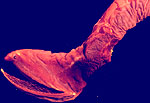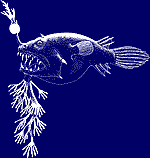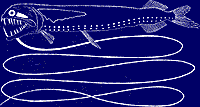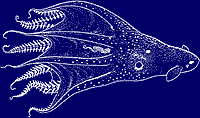
|

|

|
Deep-Sea Bestiary
Part 2
(back to Part 1)
You wouldn't want to meet a hungry
Saccopharynx lavenbergi in the depths. These
babies can reach six feet in length, have rows of
sharp little teeth, and, like pythons of the deep,
can swallow prey much fatter than themselves. They
down victims whole, of course, which is why they're
called "gulpers." They simply ease them
through their "sack-gullet" (hence the term
Saccopharynx) and into their stomach, where
digestion takes over.
|

|

|
"No, it can't be," might be your first reaction on
seeing the deep-sea
anglerfish Linophryne arborifera, whose genus
name means "toad that fishes with a net" (which
shows you how baffled scientists were initially,
too). In this species, both the pearl-onion bulb
atop the head and the hanging garden of
bioluminescent filaments below glow as a lure to
unsuspecting prey, which meet a nasty end in its
ferociously fanged jaws. As artist Richard Ellis
points out, this coal-black fish would surely be
considered "one of the most horrifying of sea
monsters" were it not the size of a baby's fist.
|
It's hard to say which is more fantastic, the fish
or its name.
Grammatostomias flagellibarba, whose name
means "lined stomiatid with a whip-barbel," is only
six inches long, but its chin barbel can be six feet
in length. As if such an absurd appendage were not
enough to impress friends and enemies alike, this
fanged freak of the deep, with its double row of
luminously blue-violet organs running down its
flanks, can light up like nature's stab at a
spaceship.
|

|

|
For its size, the
"vampire squid from hell," Vampyroteuthis
infernalis,
has the largest eyes of any animal. A six-inch
specimen bears globular eyeballs the size of a large
dog's. Such impressive orbs, coupled with its
winglike fins and its ability to turn on and off at
will a constellation of photophores—tiny
lights all over its body—help this dark-bodied
beast find prey at the lightless depths at which it
lives, more than 3,000 feet down.
|
Biologists have gone to great lengths to describe
the
long-nosed chimaera, Harriotta raleighana,
whose kind can reach five feet in length. Its
stiletto-like nose reminded one of "the nose contour
of a supersonic jet aircraft." Others have dubbed it
"rattail," for obvious reasons. In South Africa, it
is known as the "ghost shark," though it is only
distantly related to sharks. A touch of the venomous
spine on the first dorsal fin can kill a person,
though such a fate is unlikely given the 8,000-foot
depths at which this creature lives.
|

|
Continue
The Mission |
Life in the Abyss |
The Last Frontier |
Dispatches
E-mail |
Resources |
Table of Contents
|
Abyss Home
Editor's Picks
|
Previous Sites
|
Join Us/E-mail
|
TV/Web Schedule
About NOVA |
Teachers |
Site Map |
Shop |
Jobs |
Search |
To print
PBS Online |
NOVA Online |
WGBH
©
| Updated October 2000
|
|
|







